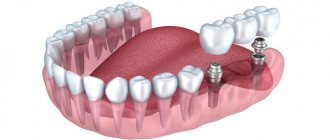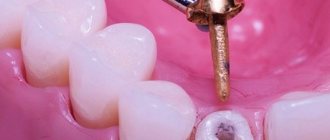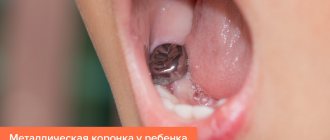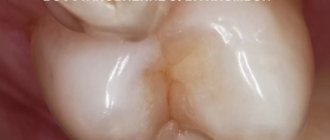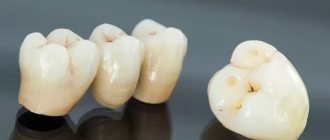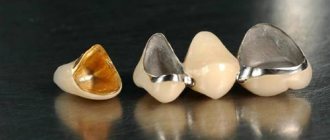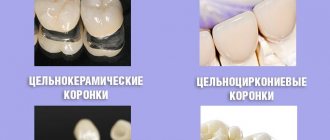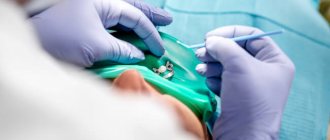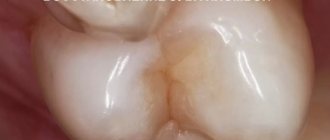To restore partially damaged teeth, dentists recommend installing crowns on pins or core inlays. They allow you to maintain chewing function and prevent further destruction and loss of teeth. This is one of the most popular and affordable types of prosthetics.
The service life of microprostheses largely depends on the following factors:
- quality of orthopedic treatment,
- chewing load,
- compliance with doctor's recommendations,
- oral care,
- patient's habits.
Do you notice that the crown on your front tooth is loose? Are you afraid that it will fall out at the most inopportune moment? Contact an experienced orthopedic dentist. The doctor will examine the restored tooth and tell you what measures can be taken.
The crown on a tooth has become loose - what to do? What could be the reason and how to solve this problem
In case of severe destruction or even complete absence of a tooth, the best option would be to restore it using an artificial crown - supported by a pin or stump inlay, or with the preliminary installation of an implant if the root system is missing. When using high-quality materials and following the technology for performing the procedure, such a single prosthesis will hold firmly and successfully perform its functions for a long time. But if the crown is loose on the tooth, this may be due to an injury or poor treatment. Read further in this article about what to do in such a situation.
What are the reasons for implant loosening?
In some cases, the doctor who performed the implantation is to blame for loosening the implant. His list of mistakes includes:
- incorrect choice of rod size;
- overheating of tissues during preparatory procedures;
- ignoring requirements regarding sterility;
- ill-conceived placement of the structure in the oral cavity;
- unacceptable superficial examination of the patient’s current condition;
- the use of low-quality or simply counterfeit insert systems.
Much more often, the culprit of his own problems is the patient himself, who naively thinks that following the doctor’s instructions after surgery is not necessary. Here are typical regime violations that lead to loosening of the structure:
- self-medication;
- refusal to perform procedures prescribed by a doctor, even partially;
- excessive heating or cooling of the body during the recovery period;
- negligent attitude towards oral hygiene;
- eating solid or tough foods soon after implant placement, earlier than allowed;
- refusal of regular examinations by the treating dentist;
- hiding from the doctor health problems that are a contraindication for implant installation.
It also happens that the implant begins to wobble due to the patient’s health deteriorating. This happens due to some injuries, infection with tuberculosis or the manifestation of cardiovascular diseases, as well as a general deterioration of immunity, especially against the background of HIV infection. Tumor processes in the body also significantly worsen the prognosis.
Why can a crown become loose and what does the strength of cement depend on?
An artificial crown is a single prosthesis that can be fixed to a tooth stump, a pin, a stump inlay or an implant abutment. This is the optimal way to restore a badly damaged or completely missing tooth. If such a crown begins to wobble, there is always a reason. The prerequisite may well be an injury or a medical error made during prosthetics. Mobility of the prosthesis in the latter case is not the only possible complication. Often, poor-quality treatment leads to the development of inflammatory and purulent processes, the development of periodontitis and periostitis.
Inflammation may be the cause of unsteadiness
If the prosthetic device wobbles, this may also indicate changes in the structure of the tissues of the stump after grinding the tooth. During the preparation process, it is necessary to preserve the structure of living tissues, as well as provide abundant water cooling. Otherwise, the hard tissues being processed will overheat, which will inevitably affect their strength and elasticity. With such a clinical picture, soon after prosthetics, the artificial crown may become loose, and then the optimal solution to the problem would be a complete replacement of the structure.
The quality of dental tissue directly affects the strength of fixation of products and the adhesive properties of the dental cement used. For prosthetics to be successful, the doctor must take into account the characteristics of the patient’s bite, the current state of his gums and bone tissue. To do this, a comprehensive diagnosis is first carried out, including an X-ray examination.
What causes the crown to become loose?
Part of the dental examination is taking an anamnesis, especially if the denture is several years old and you came to a different doctor with a problem than the one who installed it.
The fact is that there are objective reasons for the loosening of crowns.
Dental cement changes its structure over time, and its adhesive (adhesion-promoting) properties are lost. The crowns on the front teeth become loose especially often, because each bite leads to less grip.
Another objective reason is gum recession (loss). With age, the gums sag, covering the roots less and less. A gap forms between the restoration and the gum, where food debris gets in and colonies of bacteria begin to flourish. They destroy hard tissues, the stump becomes smaller, and the prosthesis cannot stay on it.
Therefore, dentists recommend replacing crowns regularly. Most often, a metal-ceramic crown wobbles, because the stump is heavily ground down for it, and the structure itself is massive, with thick walls. The service life of such crowns is the shortest: 5-7 years
. The stronger the material, the thinner the crown, the better the fit, and therefore the longer the service life. Therefore, ceramic restorations and products made from zirconium dioxide can be worn for decades.
But there are other reasons why the crown on a tooth becomes loose.
- Incorrect preparation
The stump for prosthetics must meet certain requirements: slightly taper towards the lower edge, be at least 3 mm in height (4 mm for molars).
If the doctor did excessive grinding, then the crown will slide off the tooth like a slide, even in the presence of cement. There should be a minimum gap between the tooth stump and the walls of the crown. The smaller the gap, the more reliable it is.
Perhaps the tooth was initially short and the doctor did nothing to grow it to the desired size. You can glue the crown, but it will still fall off. The higher the tooth, the better the crown is fixed on it.
The solution to the problem is to build up the stump with composite materials or inlays.
- Problems with cement
Dental materials are expensive and some clinics buy cheap materials from unknown manufacturers. Patients suffer from such savings.
Another case is when the cement is of high quality, but the technology for its preparation has been violated. The adhesive properties of such cement will not be good enough for the prosthesis to last for several years.
When re-prosthetics or re-installation, it is necessary to maintain proportions when mixing cement and use a quality product.
- Violation of manufacturing technology
The quality of the crown depends not only on the orthopedist, but also on the technician who makes it. A qualified technician follows all the requirements for the manufacturing process and always carries out sandblasting. It makes the inner surface rough, and this increases adhesion (adhesion).
Compliance with manufacturing requirements will improve the quality of the prosthesis and extend its service life.
- Loss of hard tissue
Before prosthetics, teeth are often depulped and the nerve (pulp) is removed. Therefore, during caries, the tooth under the crown does not hurt, but it can be destroyed. If caries destroys most of the hard tissues, the crown will begin to wobble, because the volume of the stump will decrease.
The patient himself can understand that the tooth under restoration is inflamed only by the smell from under the crown. In dentistry, for diagnosis, a targeted photograph is used, in which the lesion is visible. After treatment, the orthopedist will build up the stump or use microprostheses before installing the crown. If the tooth cannot be saved, it will be removed. The dentition can be restored with a bridge or implant. Implantation will avoid grinding down adjacent teeth and prevent bone loss. The bridge cannot stop atrophy.
Why does de-cementing occur in some cases?
Before installing a single denture, the dentist covers the protruding ground part of the tooth (stump) with a special cap. The product can also be fixed with support on a pin or stump insert. Dental cement is usually used to secure structural elements. If the composition is not of sufficient quality, it will not be possible to achieve strong fixation. In such a situation, the mobility of metal ceramics may be due to the use of too thin or thick cementitious composition.
In other situations, loosening of an artificial tooth becomes a consequence of an incorrect bite if the specialist did not take this point into account before performing prosthetics. Mobility also occurs when small particles of food get under the cap, which is usually the result of incorrect preparation of the ledge or a loose fit of the product.
The photo shows the decementation of the tooth crown
The shape of the inner surface of such a cap must exactly correspond to the anatomical parameters of the stump. This is necessary to ensure tight contact of the product with the stump structure or dental tissues, depending on the method of installing the prosthesis. If the contact density is insufficient, the product will soon become loose and risk simply falling out.
Thus, among the main reasons for decementation, experts in the field of prosthetics identify the following prerequisites: inaccuracy in the shape of the cap or the crown itself, poor preparation of the stump and errors in its preparation, ignoring the characteristics of the bite, and the use of low-quality cement1.
General overview
Dental implants, integrated into the structure of bone tissue or the oral mucosa, can serve as the basis for various types of prosthetic systems:
- Permanent bridge-type structures;
- Single fixed or conditionally removable systems;
- Removable structures of full or partial replacement.
The implant itself is a product made of a biologically compatible material - usually titanium, in its pure form, or with the addition of alloys - consisting of two parts:
- The intraosseous part, or body of the implant, shaped like a cone, cylinder, or something in between. In rare cases, the rod can also be made in the form of a plate. The main functional task is to replace the root section of a lost tooth, taking over and then distributing the chewing load. The body of the implant is implanted into the structure of the bone tissue, and in case of its insufficiency and restrictions on plastic surgery, into the zygomatic or basal bone.
- An abutment is a fixing element that acts as a connecting link between the pin and the artificial crown that replaces the outer part of the tooth. The abutment transfers the load to which the prosthesis is exposed to the intraosseous body, and also provides protection against damage to the internal tissues of the jaw by pathogenic infections. In some cases, a monolithic design is allowed, when the implant and abutment are a single whole.
Attaching an artificial crown or prosthesis to an abutment involves the use of dental cement, as well as screw or ball-shaped retainers.
How to solve a problem
If the crown is loose on a front or back tooth, do not try to remove it yourself. Only a specialist can do this correctly. After this, the doctor will carefully remove the cement and other elements of the system. After this, you will need to restore the shape of the stump or replace the stump tab. You will have to create a new single prosthesis and install it after all preliminary measures.
If the cause is a cyst
A cyst is a pathological neoplasm in the thickness of the gingival tissue, in the root region. As it grows and fills with purulent exudate, it provokes such unpleasant symptoms as pain with throbbing, inflammation and redness of the gums, the formation of a dense painful lump, increased body temperature and enlarged submandibular lymph nodes.
The photo shows a cyst above the crown
The appearance of a cyst after prosthetics is most often a consequence of the doctor’s negligence, neglect of the rules of asepsis and antisepsis. If you have aching, shooting pain, see a doctor immediately. You will have to take an x-ray to make an accurate diagnosis and prescribe appropriate treatment measures. Sometimes it is enough to remove the tumor surgically, possibly with resection of the root apex. In advanced cases, the tooth is completely removed and subsequent prosthetics are performed on an implant.
After removal of the cyst, the canals are re-treated within 7-10 days. In some cases, specialists prescribe antibiotics, treat the internal structures of the tooth with antiseptics, apply anti-inflammatory drugs and provide temporary prosthetics. Only after complete relief of the pathological process can a permanent prosthesis be installed.
Inflammatory process
If the denture is poorly fixed and a significant gap (more than 0.3 mm) remains between it and the gum, suitable conditions arise for the rapid proliferation of pathogenic microorganisms. Moreover, food debris will constantly get stuck in such a gap and plaque will accumulate. As a result, this will lead to redness and swelling of the adjacent gums - the development of an inflammatory process. Among its characteristic signs, experts identify the following symptoms:
- soreness,
- bleeding,
- severe swelling,
- increased reaction to mechanical and temperature stimuli,
- bad breath due to the addition of purulent processes.
Swelling and pus may form under the crown.
With such a clinical picture, urgent dental care is needed. First you need to find the source of inflammation and stop it. To do this, the doctor will remove the crown and carry out a comprehensive cleaning of the teeth from plaque and subgingival calculus. In the future, the patient will be prescribed antiseptic and anti-inflammatory drugs for self-administration: rinsing solutions (Stomatofit, Rotokan, Chlorophyllipt, Furacilin, etc.) and ointments (Solcoseryl, Cholisal, Asepta) etc.). Only after successful complex therapy will the doctor be able to perform repeated prosthetics.
If the crown falls out along with the implant
If the prosthesis has become mobile and it is installed on an implant, it is better to urgently see your attending surgeon. At any moment, the entire implant system can fall out and lead to other serious consequences, including inflammation of the jaw bone and the rapid development of osteomyelitis. If mobility and loss of the implant occurs due to the development of complications, for example, due to an inflammatory process, peri-implantitis or rejection of the structure, then you need to act very quickly.
The photo shows peri-implantitis
“When I placed my first implant, I encountered a complication. The tissue around the already installed rod became inflamed, and after about a month, that is, not immediately. I had to urgently remove everything and undergo quite a long treatment. I felt terrible then. Until now, no one has really explained to me what happened. I was given a new implant only six months later, and I had to pay the full amount for it again. A very bad experience, after that incident I changed clinics, but I forgot that one like a bad dream.”
Evgenia K., from correspondence on the 32top.ru forum
Usually the entire structure has to be removed, after which anti-inflammatory and antibacterial therapy is carried out. Perhaps, after stopping the pathological process, it will be necessary to perform osteoplasty - to replenish the atrophied areas of bone tissue. After such an operation, you need to wait from 3 to 6 months until the planted material has completely taken root. Only after this can we return to the issue of re-implantation.
What treatment methods are used
Treatment for mobility of the structure depends on the cause of the problem. If the implant crown is loose and the intraosseous element itself is motionless, it is again secured with a screw or cement. When the entire structure is wobbly, including the artificial root, treatment tactics are selected according to the clinical picture. The most favorable option is that the implant wobbles slightly, there is no inflammation around it, and the gums do not hurt.
In the second scenario, loosening of the artificial root occurs against the background of inflammation and pain in the jaw. Treatment includes:
- Cleaning the implant and nearby tissues - opening abscesses (if any), ultrasonic cleaning of plaque in the subgingival area.
- Osteoplasty using osteoplastic material and barrier membranes (according to indications).
- Antibacterial, antihistamine, anti-inflammatory agents.
- Treatment of the oral cavity with antiseptic compounds.
- X-ray control at each stage of treatment.
After the inflammation is eliminated, the prosthesis is again fixed to the implant. If the intraosseous element is rejected, it is removed from the socket, necrotic tissue is removed, and bone grafting is performed. Re-implantation is possible only after 6-8 months, when the bone mass has taken root and the tissue has recovered to its parameters.
What can you do at home?
If you are unable to get an appointment with a specialist in the near future, before visiting the doctor you should ensure the maximum level of hygiene and also treat the problem tooth with care. As optimal antiseptic measures, rinsing with Chlorhexidine or Miramistin, tincture of propolis or calendula is recommended, especially if there are signs of an inflammatory process. Among traditional medicine, chamomile, sage, oak bark, and soda-salt solution have proven themselves to be quite good.
Chamomile decoction helps well in treatment
In what cases should you not install a bridge?
To avoid questions about why a dental bridge is loose and what to do if it becomes mobile, you need to know about the contraindications specifically for this type of prosthesis. It is clear that if there are no outer teeth in a row or there are no more than 4 teeth in a row, then it will not be possible to install a bridge. But there are also hidden or unknown to the patient pathologies - contraindications. They can only be detected with careful preparation for treatment - we add that this is the responsibility of the dentist. But some specialists neglect diagnosis, and as a result the patient suffers.
Conditions when bridge prosthetics on natural supporting teeth are prohibited are as follows:
- atrophy or “subsidence” of the bone in the area of support: atrophy will continue further, while the gums will begin to recede, and the tooth necks and roots will be exposed. Therefore, there is a risk of inflammation or caries; the supports themselves may begin to wobble, because lose fixation in the bone,
- inflammation and bleeding of gums,
- late stages of periodontitis and periodontal disease (these pathologies are easily diagnosed): a whole range of problems is observed here - bone atrophy, inflammation and decrease in the level of gums, tooth mobility,
- “undetected” pulpitis or periodontitis in supporting units: the dentist did not remove the “dental nerve” - depulpation (although now doctors always try to do this before prosthetics),
- the presence of cysts and granulomas under the roots,
- cracks in the roots
- poor canal filling during previous treatment (and the doctor did not notice this),
- malocclusion,
- bruxism and increased tone of the masticatory muscles.
Preventive measures
To reduce the risk of the crown loosening and falling out, it is important to strictly follow the specialist’s instructions after the procedure, as well as maintain cleanliness and hygiene of the oral cavity. Here's what prosthetics experts recommend in this regard:
- brush your teeth twice a day, rinse your mouth after every meal, use floss. It is advisable to purchase an irrigator - a device that supplies a powerful air-water jet for better cleaning of hard-to-reach places. You can read more about the principle of operation of the irrigator and popular models of the device in our special article,
- follow some nutritional principles. For example, immediately after the procedure you will have to give up products that are too hard and stretchy. Subsequently, it is better to forget about the habit of gnawing seeds with your teeth and cracking the shell,
- It is better to quit smoking and drinking alcohol too often,
- treat the installed structure carefully and carefully, regularly check it for chips, cracks and other damage,
- When the first alarming symptoms appear, you should immediately consult a doctor.
To maintain your smile, proper dental hygiene is important.
After dentures, do not forget to visit the dentist every six months for preventive examinations and a professional. hygiene. At each such appointment, the doctor will evaluate not only the condition of the teeth and gums, but also the integrity and functionality of the installed dentures. If necessary, when the product’s expiration date approaches, a specialist will prescribe its timely replacement.
1Massironi, D. Precision and aesthetics. Clinical and dental stages of dental prosthetics, 2008.
Why the bridge prosthesis is loose in the mouth - the reasons for mobility and how to deal with them
Article navigation
- Causes of instability
- When not to build a bridge
- Diagnostics
- Remove the movable prosthesis
- Prosthetics provided that the supports are intact
- Prosthetics, if supports have to be removed
- Strengthen the bridge yourself
- How long can a prosthesis last?
- When is the best time to replace a bridge?
question to a specialist
When a dental bridge becomes loose, a person involuntarily asks questions - is this normal and what to do? Looking ahead, let's say that this is not the norm, and delaying the correction of the situation can lead to complications. Why a dental bridge can wobble immediately after installation, after several months or years, whether it can be strengthened and how to do it correctly, read in the following material.
Is it possible to remove the crown?
Almost every patient who has undergone orthopedic treatment wonders whether it is possible to remove the crown from a tooth. Installing a crown is a non-removable type of prosthetics, but this does not mean that they cannot be removed in principle. In dentistry, removable dentures are those structures that can be pulled out of the mouth independently. In turn, fixed dentures are removed in the dentist's office using special equipment and tools. Another popular question: which doctor removes crowns from teeth? This should be done by an orthopedic dentist, but in some clinics the therapist also removes crowns, which, of course, is not entirely correct.
A temporary crown fell out: what to do?
If a temporary plastic crown falls out or breaks during treatment, turning, preparation for prostheses (implants), then there is only one way out - inform the doctor about this as soon as possible and make another temporary crown.
What happens if you don't do this:
— The tooth will remain uncoated, which will make it vulnerable to various diseases: caries, decay, etc., which will entail additional dental procedures and financial expenses. Also, you will simply waste your time.
— When you remove a damaged temporary crown, and the tooth underneath is left without support and contact with neighboring teeth, it may come out over time. As a result, it will be impossible to install a permanent crown and the tooth will have to be ground down again. And if you overdo it a little with grinding the tooth, you can get to the nerve, which will completely ruin the living tooth, and then the need for depulpation will immediately arise.
If the temporary crown on the implant is loose, it needs to be returned to its place as soon as possible or a new one made.

